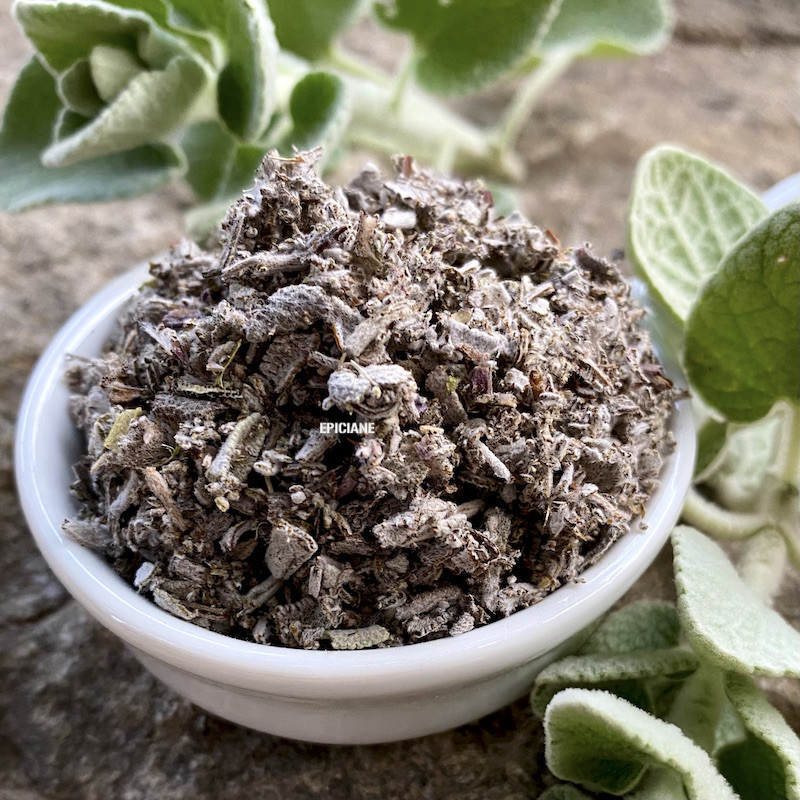
Reference: 021122


It is very aromatic, delightfully bitter, and slightly camphorous.
An endless source of wellness, it pairs well with many meats (pork, lamb) as well as certain fatty fish (salmon).
 Delivery
Delivery
Mondial Relay
 Returns
Returns
See conditions
 Payments
Payments
100% secure
Livré en sachet refermable
Uses in Cooking and Beyond:
Common sage (Salvia officinalis), the variety here, is both aromatic and medicinal and even decorative in gardens where bees enjoy gathering nectar from its flowers.
Sage’s robust flavor pairs especially well with pork, lamb, fatty poultry like duck, oily fish like salmon, and even potatoes, helping with digestion for these richer foods. It’s also used in marinades for meats, especially game, due to its digestive properties for heavier dishes.
Sage works wonders in fish broths and charcuterie, like sausages, where it extends shelf life thanks to its antibacterial qualities.
A simple dish idea: dip fresh sage leaves in batter and fry them in oil.
Sage can also be found in fougasse and certain breads. In tea, it is highly digestive.
Its essential oil is even used in perfumery, soaps, toothpaste, and some cosmetics.
Finally, sage is an excellent source of vitamin K and iron.
Who Am I?
Origin: Turkey
Scientific Name: Salvia officinalis
Common Names: Sacred Herb, European Tea
Sage includes numerous varieties, all belonging to the Salvia genus, within the Lamiaceae family. There are over 900 species, including annuals, biennials, perennials, and purely decorative types. Many varieties grow naturally in Europe, like meadow sage, and can be found in all temperate zones worldwide, thriving in well-drained, sunny soils.
A Provençal saying, "He who has sage in his garden needs no doctor," illustrates its many reputed virtues. Its Latin name, salvia, from salvare (meaning "to save" or "to heal"), reflects its historical importance in herbal medicine.
A Little History:
Medicinal sage originates from Western Asia. The term "sage" appeared in France in the 13th century.
Medicinal sage species, like Salvia officinalis, were believed during the Middle Ages to cure all ailments and were used in infusions and decoctions. Even Louis XIV had sage as his preferred tea, served at all hours. In the 18th century, sage leaves were rolled like cigarettes.
Other sage species with hallucinogenic effects were used in shamanic rituals by some Native American tribes and are still used occasionally today.
In China, sage leaves were so valued they were traded for the most precious teas.
Greeks, Romans, and Arabs used sage as a tonic and as a compress for snake bites.
Data sheet
Reference: 021122
Reference: 050721
Reference: PL-EK0-07
Reference: 408164502
Reference: aubepinefl
Reference: 9K5061101
Reference: laurierE
Reference: angelique
Reference: 6L5609803
Reference: 112930001
Reference: 3N7201902
Reference: gentiane
Reference: 9N7669901
Reference: 6K4878201
Reference: 121320001
Reference: 20731803
Reference: 6N7456401
Reference: 7K4954201

It is very aromatic, delightfully bitter, and slightly camphorous.
An endless source of wellness, it pairs well with many meats (pork, lamb) as well as certain fatty fish (salmon).